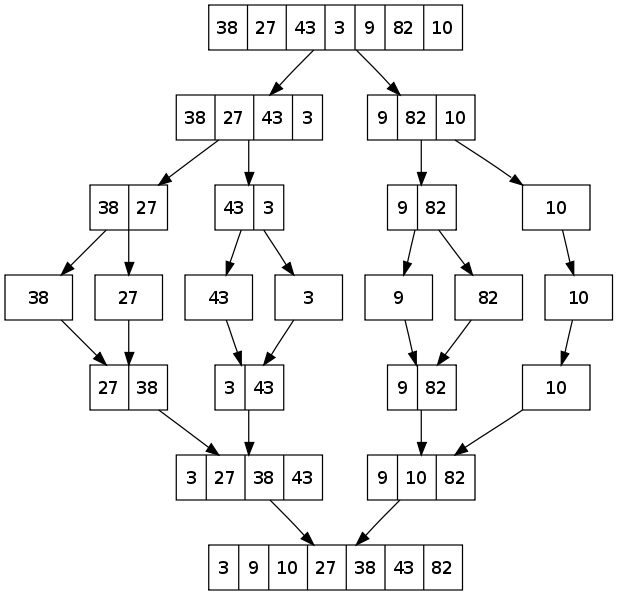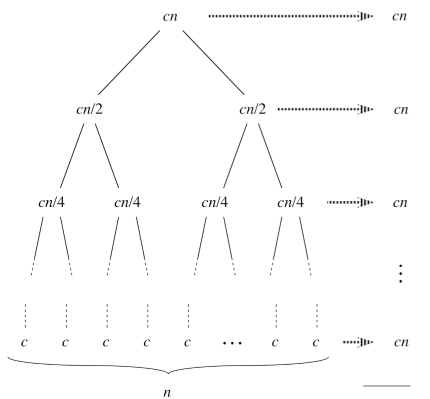Insertion Sort
Chapter 2 introduces insertion sort, an algorithm that solves the sorting problem mentioned in a previous chapter.
- Input
- A sequence of n numbers <a1, a2, …, an>
- Output
- A permutation <b1, b2, …, bn> of the input sequence such that b1 ≤ b2 ≤ … ≤ bn
INSERTION-SORT(A) cost times for j = 2 to A.length c1 n key = A[j] c2 n-1 // Insert A[j] into the sorted sequence A[1..j-1]. 0 n-1 i = j - 1 c4 n-1 while i > 0 and A[i] > key c5 Σ(j=2 to n) tj A[i+1] = A[i] c6 Σ(j=2 to n) tj - 1 i = i - 1 c7 Σ(j=2 to n) tj - 1 A[i+1] = key c8 n-1
Basically, algorithm divides the sequence in two parts. The left part A[1…j-1] constitutes the currently sorted subarray and the right part is a subarray A[j+1…n] that corresponds to the numbers to be sorted. What you want to do is to pick an element (starting from 2), go down the array and try to find a good spot to fit the number in, at the same time copying the values one place over to have a free slot for insertion.
Analyzing algorithms
- Running Time T(N)
- The running time of the algorithm is the sum of running times for each statement executed; a statement that takes ci steps to execute and executes n times will contribute cin to the total running time.
T(N) = c1*n c2(n-1) +c4(n-1) +c5Σj +c6Σ(tj-1) +c7Σ(tj-1) +c8(n-1).
Algorithm’s running time does depend on the input. For example, if the input array is sorted, we would have A[i] key when i has its initial value of j-1. Thus tj = 1 for j = 2, 3 … n and the T(N) would be:
T(N) = c1n +c2(n-1) +c4(n-1) +c5(n-1) +c8(n-1) = (c1+..c8)n - (c2+c4+c5+c8) = Cn - c
This clearly looks like a linear function of n.
Another example, array is in reverse sorted order, then we must compare the entire left subarray which would make tj = j for j = 2, 3 … n. Consequently, T(N) would look like:
T(N) = c1n +c2(n-1) +c4(n-1) +c5(n(n+1)/2-1) + c6(n(n-1)/2) + c7(n(n-1)/2) +c8(n-1)
= Cn2 + Cn - c
This clearly looks like a quadratic function of n.
Notice that Σ(j=2 to n)[j] = n(n+1)/2-1 and Σ(j=2 to n)[j-1] = n(n-1)/2
When we try to analyze algorithms, we usually only care about finding the worst-case running times. Why?
- It gives an upper bound on the running time for any input. Knowing it provides a guarantee that the algorithm will never take any longer.
- In some cases, worst case occurs fairly often (e.g. searching a database for non-existent information)
- The “average case” is often roughly as bad as the worst case. For example, imagine that half of the elements in A[1…j-1] are less than A[j] and half are greater. It would make tj = j/2 which would be the same quadratic formula but divided by a constant (2), not a huge difference.
To denote the worst case we write the running time of Θ(n2) (pronounced “theta of n-squared”) which represents a rate of growth or order of growth. We can ignore the lower-order terms because they are relatively insignificant for large values of n. All we care about is the leading term of the formula (e.g., cn2).
Algorithm Design & Mergesort
Sometimes, we can come up with a different approach to tackle the same problem. So far we used an incremental approach: to sort the subarray A[1…j-1], we inserted a single element A[j] into its proper place, yielding the sorted subarray. A different way of doing things would be using divide-and-conquer method: break the problem into several subproblems that are similar to the original problem but smaller in size, solve the subproblems recursively, and finally combine these solutions to create a solution to the original problem. Mergesort algorithm would be a good example of this.
Divide: Divide the n-element sequence to be sorted into two subsequences of n/2 elements each.
Conquer: Sort the two subsequences recursively using merge sort.
Combine: Merge the two sorted subsequences to produce a fully sorted sequence.
The following MERGE function merges two sorted subarrays A[p..q] and A[q + 1..r] where p ≤ q ≤ r. It merges them to form a single sorted subarray that replaces the current subarray A[p..r]. Since we perform at most n steps, where each step is just a comparing of two elements from left and right subarrays, merging takes Θ(N) time.
MERGE(A,p,q,r) n1 = q-p+1 n2 = r-q let L[1..n1+1] and R[1..n2 +1] be new arrays for i = 1 to n1 L[i] = A[p+i-1] for j=1 to n2 R[j] = A[q+j] L[n1+1] = inf L[n2+1] = inf i = 1 j = 1 for k = p to r if L[i] <= R[j] A[k] = L[i] i = i + 1 else A[k] = R[j] j = j + 1
- Compute the length of A[p..q] and A[q+1..r].
- Create left and right of lengths n1+1 and n2+1. Extra position holds the sentinel which would simplify our code.
- For loops copy the subarray A[p..q] into L[1..n1] and A[q+1..r] into R[1..n2].
- Put the sentinels.
- Put the values in A in order.
Now we can use merge procedure as a subroutine in the merge sort algorithm. The procedure sorts the elements in the subarray A[p..r]. If p ≥ r the subarray has at most one element and is therefore already sorted. Otherwise, the divide step simply computes an index q that partitions A[p..r] into two subarrays: A[p..q], containing ceil(n/2) elements and A[q+1..r], containing floor(n/2) elements.
MERGE-SORT(A,p,r) if p < r q = floor((p+r)/2) MERGE-SORT(A,p,q) MERGE-SORT(A,q+1,r) MERGE(A,p,q,r)
To sort an entire array, we make the initial call MERGE-SORT(A,1,A.length). The algorithms goes all the way to the bottom, merges pairs of 1-item seqs to form sorted seqs of length 2, merges pairs of seqs of length 2 to form sorted seqs of length 4 and so on, until two sequences of length n/2 are merged to form the final sorted sequence of length n.

Runtime Complexity
T(n) is either going to be Θ(1) if n ≤ c or aT(n/b) + D(n) + C(n).
In our case:
1) D(n) is Θ(1) operation (finding q) [Divide]
2) We recursively solve two subproblems, each of size n/2, which contributes to 2T(n/2) to the running time [Conquer]
3) We have seen that MERGE takes Θ(N) time on n-element subarray so C(N) = Θ(N) [Combine]
Thus, we get T(n) = Θ(1) [if n ≤ c] or 2T*(n/2) + Θ(n) [if n > 1]
So what exactly is 2T*(n/2)? To find it out, let’s refer to a recursion tree to better understand the first term.
- Recursion Tree
- A recursion tree is useful for visualizing what happens when a recurrence is iterated. It diagrams the tree of recursive calls and the amount of work done at each call.

First level takes cn time.
Second level takes 2(cn/2) = cn.
Third level takes 4(cn/4) = cn.
To find out the total running time we need to sum up all the costs on each level. How do we know the number of levels?
- Number of levels of the recursion tree
- The total number of levels of the recursion tree is lgn + 1, where n is the number of leaves, corresponding to the input size.
Then, our recursion tree has lgn + 1 levels, each costing cn, for a total of cn(lgn + 1) = cnlgn + cn.
Substitute this in our previous T(n) equation and we get:
T(n) = Θ(1) [if n ≤ c] or cnlgn + cn + Θ(n) = Θ(nlgn) [if n > 1].
This is a much better runtime complexity than the insertion sort we looked at earlier.
Twitter Facebook Google+